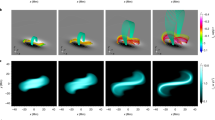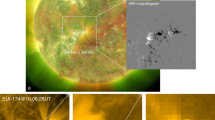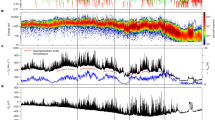Abstract
Magnetic reconnection, the process by which magnetic lines of force break and rejoin into a lower-energy configuration, is considered to be the fundamental process by which magnetic energy is converted into plasma kinetic energy1. The Sun has a large reservoir of magnetic energy, and the energy released by magnetic reconnection has been invoked to explain both large-scale events, such as solar flares2,3 and coronal mass ejections4, and small-scale phenomena, such as the coronal and chromospheric microflares that probably heat and accelerate the solar wind5,6. But the observational evidence for reconnection is largely indirect, resting on observations of variations in solar X-ray morphology and sudden changes in the magnetic topology7,8, and on the apparent association between some small-scale dynamic events and magnetic bipoles9,10. Here we report ultraviolet observations of explosive events in the solar chromosophere that reveal the presence of bi-directional plasma jets ejected from small sites above the solar surface. The structure of these jets evolves in the manner predicted by theoretical models of magnetic reconnection11,12, thereby lending strong support to the view that reconnection is the fundamental process for accelerating plasma on the Sun.
This is a preview of subscription content, access via your institution
Access options
Subscribe to this journal
Receive 51 print issues and online access
$199.00 per year
only $3.90 per issue
Buy this article
- Purchase on Springer Link
- Instant access to full article PDF
Prices may be subject to local taxes which are calculated during checkout
Similar content being viewed by others
References
Giovanelli, R. G. A theory of chromospheric flares. Nature 158, 81–82 (1946).
Gold, T. & Hoyle, F. Solar flares. Mon. Not. R. Astron. Soc. 120, 89–105 (1960).
Priest, E. R. Solar Flare Magnetohydrodynatnics (Gordon & Breach, London, 1981).
Hundhausen, A. J. in Proc. 6th Int. Solar Wind Conf. (eds Pizzo, V.J., Holzer, T. E. & Sime, D. G.) 181–214 (Nat. Center for Atmospheric Res., Boulder, 1988).
Gold, T. in AAS-NASA Symp. on Solar Flares (ed. Hess, W. N.) 389–395 (NASA-SP 50, NASA, Washington DC, 1964).
Axford, W. I. & McKenzie, J. F. in Solar Wind Seven 1–5 (eds Marsch, E. & Schwenn, R.) (Pergamon, Oxford, 1992).
Tsuneta, S. et al. Global restructuring of the coronal magnetic fields observed with the Yohkoh soft X-ray telescope. Publ. Astron. Soc. Jpn. 44, L211–L214 (1992).
Masuda, S. et al. A loop-top hard X-ray source in a compact solar flare as evidence for magnetic reconnection. Nature 371, 495–497 (1994).
Porter, J. G. et al. Microflares in the solar magnetic network. Astrophys. J. 323, 380–390 (1987).
Webb, D. F. et al. The correspondence between X-ray bright points and evolving magnetic features in the quiet Sun. Solar Phys. 144, 15–35 (1993).
Petschek, H. E. in AAS-NASA Symp. on Solar Flares (ed. Hess, W. N.) 425–437 (NASA-SP 50, NASA, Washington DC, 1964).
Priest, E. R. Solar Magnetohydrodynamics (Reidel, Norwell, MA, 1982).
Rabin, D. & Dowdy, J. F. Jr Pervasive variability in the quiet solar transition region. Astrophys. J. 398, 665–681 (1992).
Brueckner, G. E. & Bartoe, J.-D.F. Observations of high-energy jets in the corona above the quiet Sun, the heating of the corona, and the acceleration of the solar wind. Astrophys. J. 272, 329–348 (1983).
Dere, K. P., Bartoe, J.-D.F. & Brueckner, G. E. Explosive events in the solar transition zone. Solar Phys. 123, 41–68 (1989).
Dere, K. P. Explosive events, magnetic reconnection, and coronal heating. Adv. Space Res. 14, 13–22 (1994).
Brueckner, G. E. et al. HRTS results from Spacelab 2. Adv. Space Res. 6, 263–272 (1986).
Dere, K. P. et al. Explosive events and magnetic reconnection in the solar atmosphere. J. Geophys. Res. 96, 9399–9407 (1991).
Wilhelm, K. et al. SUMER—solar ultraviolet measurements of emitted radiation. Solar Phys. 162, 189–231 (1995).
Wilhelm, K. et al. First results of the SUMER telescope and spectrometer—solar ultraviolet measurements of emitted radiation—on SOHO: I. Spectra and spectroadiometry. Solar Phys. (in the press).
Lemaire, P. et al. First results of the SUMER telescope and spectrometer—solar ultraviolet measurements of emitted radiation—on SOHO: II. Imagery and data management. Solar Phys. (in the press).
Dere, K. P. et al. UV observations of macrospicules at the solar limb. Solar Phys. 119, 55–63 (1989).
Author information
Authors and Affiliations
Rights and permissions
About this article
Cite this article
Innes, D., Inhester, B., Axford, W. et al. Bi-directional plasma jets produced by magnetic reconnection on the Sun. Nature 386, 811–813 (1997). https://doi.org/10.1038/386811a0
Received:
Accepted:
Issue Date:
DOI: https://doi.org/10.1038/386811a0
This article is cited by
-
Dynamics of Explosive Events Observed by the Interface Region Imaging Spectrograph
Solar Physics (2022)
-
Particle energization in space plasmas: towards a multi-point, multi-scale plasma observatory
Experimental Astronomy (2022)
-
A New View of the Solar Interface Region from the Interface Region Imaging Spectrograph (IRIS)
Solar Physics (2021)
-
Critical Science Plan for the Daniel K. Inouye Solar Telescope (DKIST)
Solar Physics (2021)
-
Magnetic reconnection in three-dimensional quasi-helical pinches
Rendiconti Lincei. Scienze Fisiche e Naturali (2020)
Comments
By submitting a comment you agree to abide by our Terms and Community Guidelines. If you find something abusive or that does not comply with our terms or guidelines please flag it as inappropriate.



